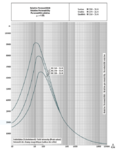CataM
Advanced Member level 4

- Joined
- Dec 23, 2015
- Messages
- 1,275
- Helped
- 314
- Reputation
- 628
- Reaction score
- 312
- Trophy points
- 83
- Location
- Madrid, Spain
- Activity points
- 8,409
Hello everyone,
I have a gapped (few mm of air gap) inductor wound around the E+I sheets of a laminated core Power Core M400-50A.
The problem that I see is that the inductance when measured with an LCR meter varies when the amplitude of the LCR varies.
The core is not saturated because it can withstand 1ARMS without saturation, so the decrease of inductance due to increase of voltage is not due to saturation.
Could this be due to the I*R drop in the series resistance ? Why could this be ?
Any comment is appreciated !
I have a gapped (few mm of air gap) inductor wound around the E+I sheets of a laminated core Power Core M400-50A.
The problem that I see is that the inductance when measured with an LCR meter varies when the amplitude of the LCR varies.
- 56mH @50 Hz @ 50mVRMS
- 50mH @50 Hz @ 300mVRMS
The core is not saturated because it can withstand 1ARMS without saturation, so the decrease of inductance due to increase of voltage is not due to saturation.
Could this be due to the I*R drop in the series resistance ? Why could this be ?
Any comment is appreciated !



